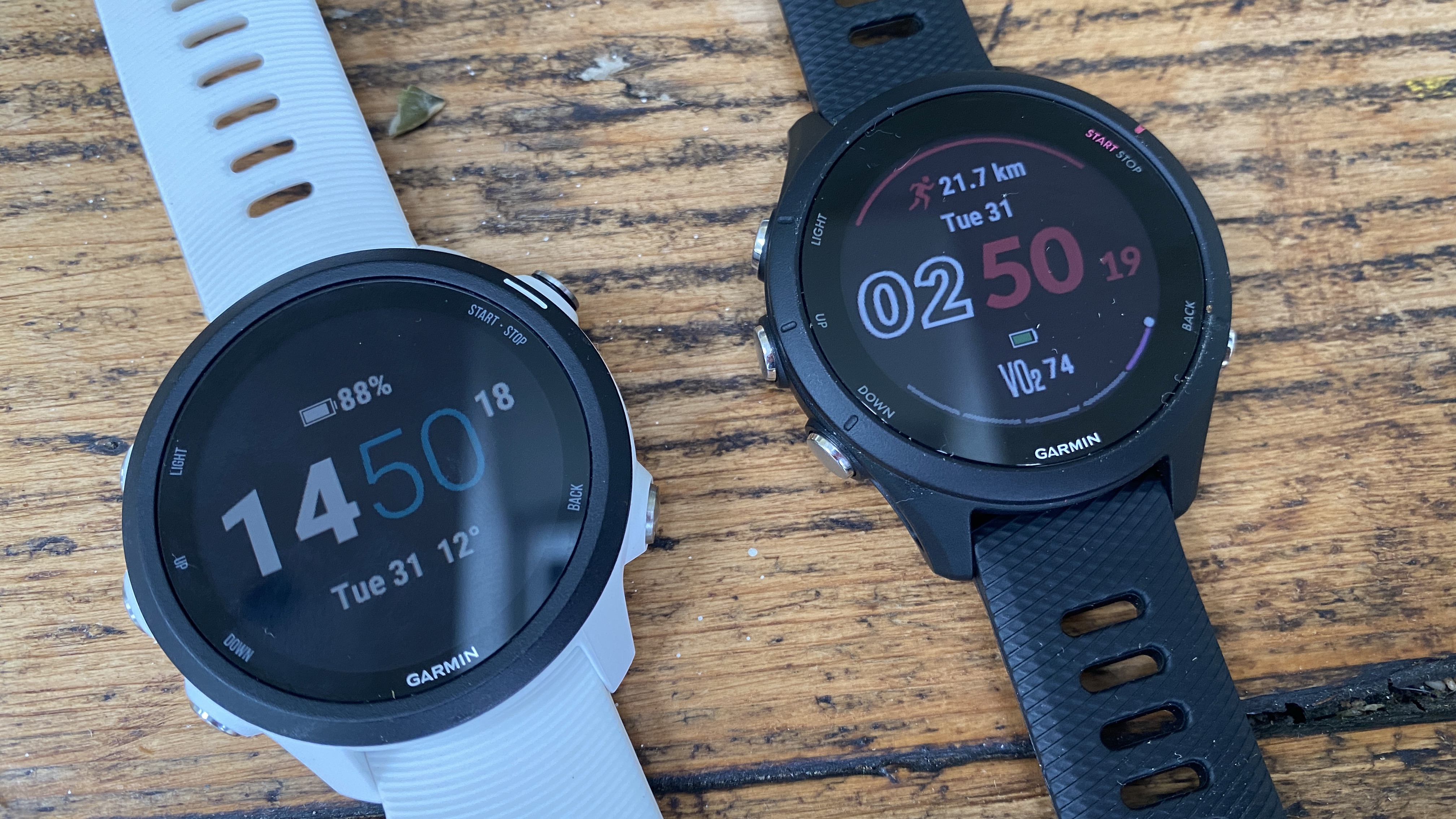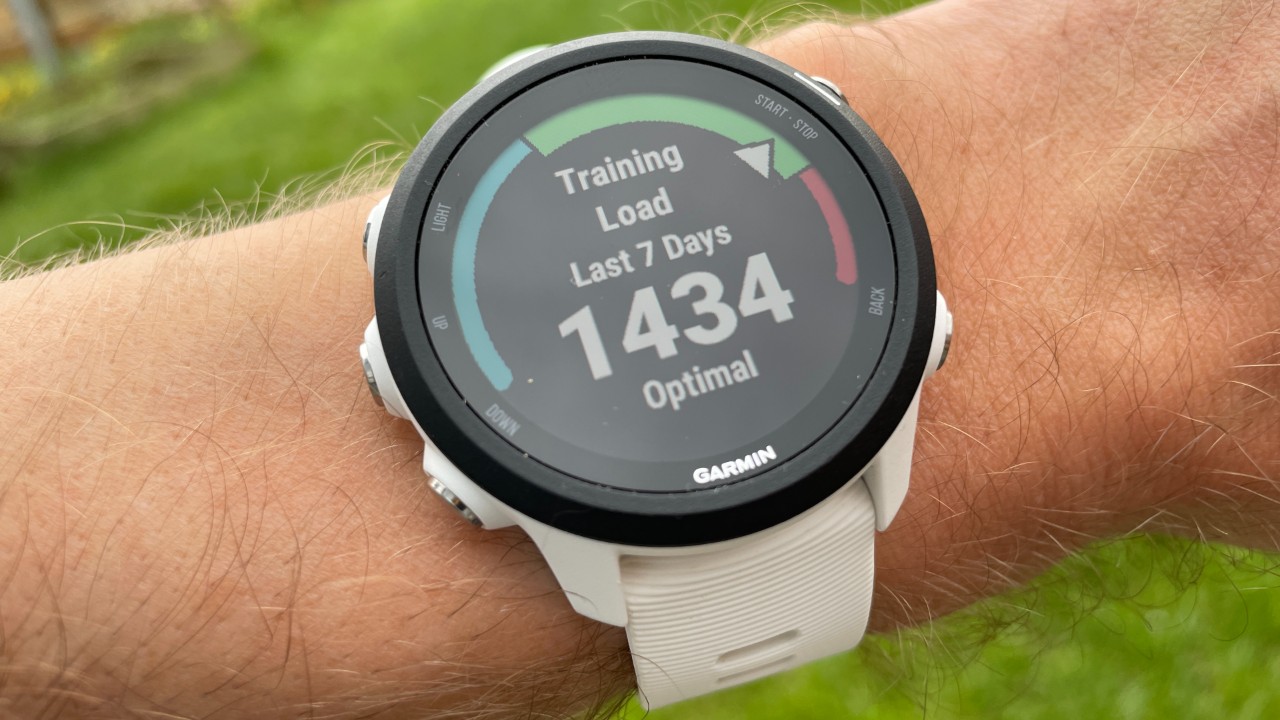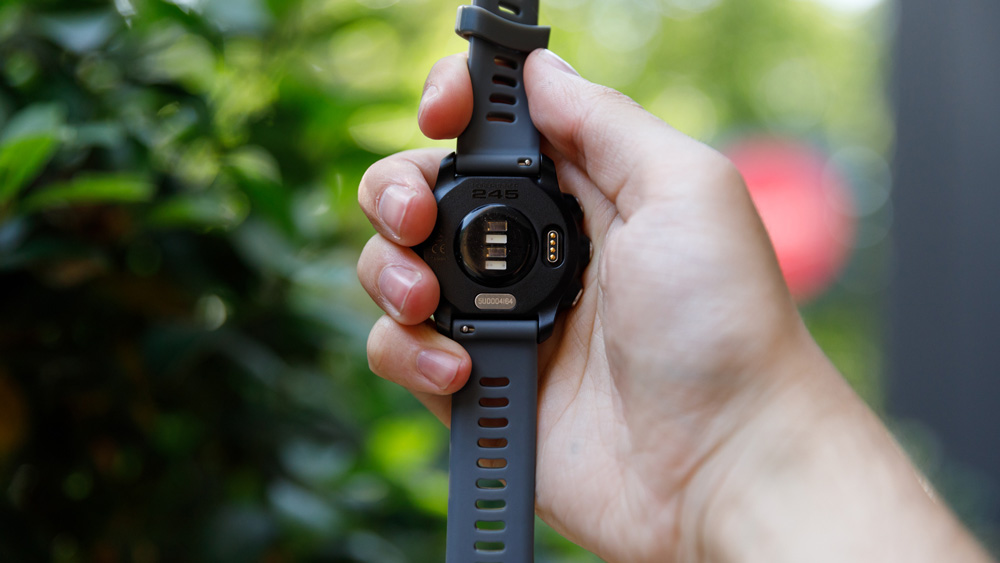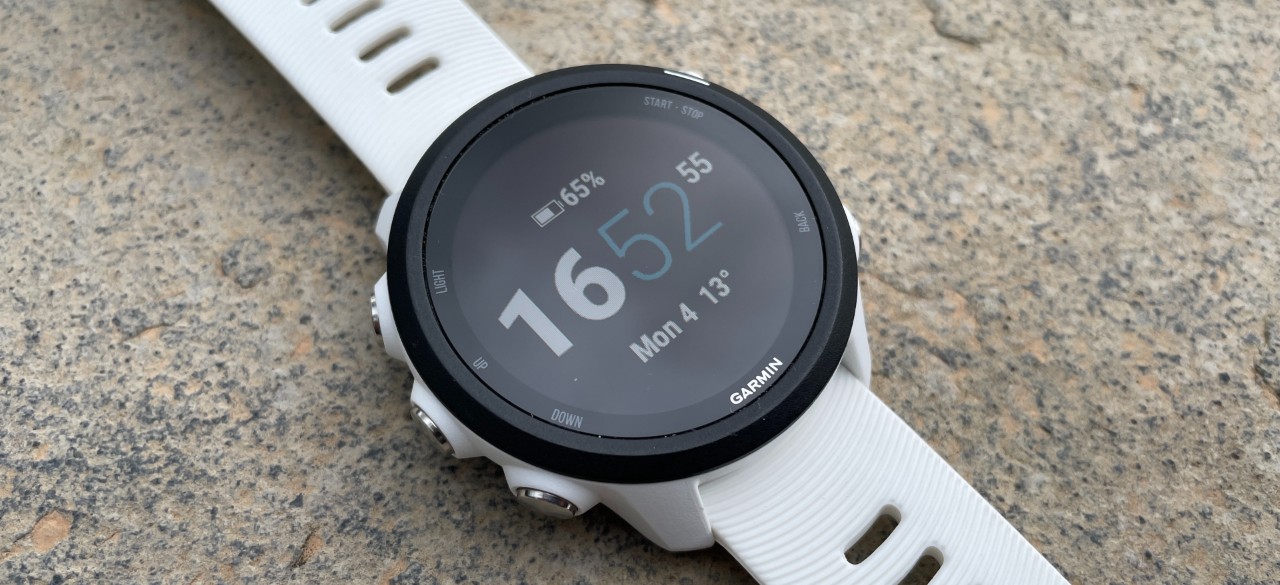Our Verdict
The Forerunner 245 provides everything a runner needs and more, and does it at an appealing price. It’s the best-value running watch you can get.
For
- Excellent sports tracking
- Breadcrumb trail navigation
- Music storage (on 245 Music only)
Against
- Battery life is good but not great
- No triathlon mode
- Sleep tracking is inaccurate
You can trust Coach
This review was originally published in May 2019, but has been updated to compare the product with new releases.
Do you want one of the best running watches with music for under $350/£300? If so, then the Forerunner 245 Music should be on your shortlist. In fact, any runner looking for a watch with music should consider the 245. There are pricier options with more features, such as the Garmin Forerunner 955 and Garmin Fenix 7, but the 245 covers everything you really need.
If music isn’t so important to you, the standard 245 is also attractive, but you can find watches that offer more for around the same price. The Polar Pacer Pro is a strong option.
There are also running watches available for under £200 that are now so good that they offer real competition to the 245. The Coros Pace 2 is a terrific running watch that costs just under $200/£200, while Garmin’s own Forerunner 55 offers accurate run tracking and structured workouts and is compatible with Garmin Coach’s training plans – even experienced runners might find it can satisfy all their tracking needs for £169.99 (or less, seeing as it won’t be long before it starts being included in Garmin sales).
The elephant in the room is the next-generation Garmin Forerunner 255. Here’s how the two stack up.
December 1, 2023: There are now regular sales and deals featuring the Garmin Forerunner 245. In our extensive coverage of the best Black Friday Garmin deals in 2023 the best price we tracked was $199.99. Our deal tracking of Amazon Prime Day Garmin deals in 2023 revealed a best price of £169.99.
Garmin Forerunner 245 Vs Garmin Forerunner 255

Garmin launched the Forerunner 255 in June 2022 and the watch is an upgrade on the Forerunner 245 in several key areas. The Forerunner 255 is a full multisport watch with a triathlon mode and support for cycling power meters, offering dual-band GPS for more accurate tracking and longer battery life (14 days in smartwatch mode vs seven on the 245, plus increases in GPS battery life).
Other updates on the new watch include overnight heart rate variability tracking, Garmin Pay NFC payments and a morning report that gives details like the weather forecast, plus your suggested workout for the day. The new watch also offers Garmin’s race calendar feature and upgraded race predictions and training load analysis, and it comes in two sizes: the standard 255 is a little larger than the 245 while the 255S is smaller.
Sign up for workout ideas, training advice, reviews of the latest gear and more.
The new features on the 255 come at a cost. Its price rises to $399.99/£349.99 for the music versions and $349.99/£299.99 for the base model. That’s a jump on the Forerunner 245’s RRP even before you consider that you can often pick up the 245 for under $200/£150 for the base model and $220/£180 for the 245 Music.
Aside from the addition of a multisport mode, which is clearly necessary for triathletes, the upgrades to the 255 mostly fall into the nice-to-have category rather than absolutely essential. The GPS is better on the 255, as is the battery life, and the improved training analysis and HRV status are both handy, but runners will get better value from the 245 if they find it at a decent discount – check the Black Friday deals available.
However, that’s for now. Bear in mind the 255 will continue to get software updates with new features while the 245 probably won’t. One example is wrist-based running power, which is expected to land on the Forerunner 255 this year, so you will get a more future-proof device if you opt for the 255.
Running With The Garmin Forerunner 245 Music

The Forerunner 245 has increased the range of sports it tracks compared to the 235, but it’s still first and foremost a running watch. And it’s a damn fine running watch, complete with all the features that you’d normally expect from a premium device. Those features include structured workouts and training plans, training analysis and recovery advice, and breadcrumb navigation, all of which comes on top of the essentials – accurate GPS and heart rate tracking.
For runners, there’s nothing significant missing from the 245. It doesn’t have a barometric altimeter, which is available on the Forerunner 645 and makes for more accurate tracking when you’re heading up and down mountains, and you can get more in-depth training analysis from pricier Garmin and Polar watches, but there will be very few runners left unsatisfied by what the 245 does.
In our tests, locking on to GPS at the start of a run was always speedy – you can opt for GPS only, GPS plus GLONASS (the Russian satellite system) or GPS plus Galileo (the European one), with the latter providing the most accurate tracking in the UK in my experience. Measured against a calibrated footpod, the 245’s distance tracking was always close to bang on, even under tree cover or on a running track, and I was similarly impressed by how accurate its heart rate tracking was. The 245 is small and light, so it sits tight against the wrist, and I found it matched up well with a chest strap heart rate monitor even during interval runs.
You can create your own workouts and beam them over to the watch from the Garmin Connect app, setting yourself targets based on time, distance, heart rate, cadence, pace or calories. You can also generate a full training plan using the Garmin Coach feature in the app. These are currently available for 5K, 10K and half marathon races and once you select one, all your training runs will be sent to the watch and you will be guided through each workout.
Along with workouts, you can also create routes in the app to follow on the 245. The watch doesn’t have full colour maps like the Forerunner 945 or Fenix 5 Plus Series, but the simple breadcrumb trail you get on the 245 is usually enough to keep you on track, and even if you do go wrong you’ll be able to get yourself back on the route quickly.
You can also ask the 245 to guide you back to your starting point in the middle of a run, so you can get yourself good and lost in the knowledge that when it’s time to head home, your watch is looking out for you.

Once you’ve finished your run, the analysis starts with an assessment of how it affected your aerobic and anaerobic fitness – the latter improves through short, fast efforts, and the former through pretty much everything else. The 245 will also give a rating of your recent training load so you can check if you’re going about things in the right way. This rating considers your overall load and whether the watch thinks it’s actually making you fitter, which is based on how it’s affecting your VO2 max. It will help runners from doing too much training, which can negatively affect your fitness.

It’s a useful feature for anyone who’s unsure how to go about structuring their training. Although it’s not as in-depth as the analysis you get on the Forerunner 945, it’s more than enough information for most runners.
That was my biggest discovery after a few weeks with the 245 – that it does more than enough to satisfy most runners. I’ve used the 945 and the Fenix 5 Plus Series as my main watches for most of 2019, and enjoyed the extra depth of training analysis and the full colour maps they offer, but I couldn’t honestly justify spending an extra £200-£250 for those features instead of plumping for the 245.
Sports Tracking With The Garmin Forerunner 245 Music
The Forerunner 245 has a wide range of sports modes, so it might seem unfair to start with some that it doesn’t have, but there you go. There isn’t a triathlon/multisport or open-water swimming mode on the watch. Garmin is steering triathletes towards one of its more expensive triathlon watches, it seems, so if a multisport mode is a dealbreaker for you check out the Coros Apex or Polar Vantage M, which are in the same price bracket as the 245.
You do get a pool swimming mode on the 245, however, and there are more indoor training modes than on the 235, including yoga, plus generic cardio and strength sessions. Many of the other sports modes on the watch are basically just a timer with heart rate and calories burned, but there are more specific stats available in the cycling and swimming modes. Pool swimmers get info on their stroke rate and SWOLF, for example, though the heart rate monitor is turned off in the water. Other trackers will attempt to take a heart rate reading from the wrist during swimming sessions, which is tricky to do with accuracy, but I’ve had decent results with some watches so it’s a little disappointing that Garmin just shuts off the function.
Overall, the 245’s sports modes will more than satisfy a runner looking to log their cross-training, but it’s not as well-rounded a sports watch as some of its competitors.
Activity Tracking With The Garmin Forerunner 245 Music
The 245 is a terrific everyday activity tracker, recording all the staple stats like steps, active minutes and calories, and supplementing those with stress tracking – which is based on heart rate variability – and Garmin’s Body Battery stat. This provides a score out of 100 rating how much energy you have, with your reserves topped up at night and gradually dropping throughout the day depending on how active you are.
If you’re buying the 245, you’re probably doing so for its sports tracking, but I’d expect most people to be pleasantly surprised by the standard of its everyday tracking too.

Sleep Tracking With The Garmin Forerunner 245/245 Music
If sleep tracking is important for you then Garmin’s offering will be a disappointment compared with the depth of detail you get from Fitbit and Polar devices in particular. The 245 will track sleep and break it down by time spent in deep, light and REM sleep, along with any time awake, but it’s pretty basic and often inaccurate (recording periods when I’m awake but still as light sleep) so overall sleep total is skewed to be too high.
You can also enable the PulseOx sensor to record your blood oxygen levels during sleep, which might be of use to those at altitude, and could help identify conditions like sleep apnoea in the future if Garmin updates the software on the watch. Right now, however, it’s pretty much useless for most people, so turn it off and save the battery life.
Battery Life On The Garmin Forerunner 245/245 Music

This depends on whether you’re using the music features of the 245 frequently. If so, you get six hours of GPS plus music, as opposed to 24 hours of GPS alone. If you are using the music feature every time you run or work out, you’ll need to charge the watch every two to three days or so, while if you’re using it more sporadically then you can probably get by with a once-a-week charge. If you get the basic 245 without music then you can rely on it for seven to ten days of battery life even with frequent training.
Design Of The Garmin Forerunner 245 Music
I was impressed by the design of the 245, which is much less plasticky and sporty than the 235. It’s subtle enough to wear everywhere in my opinion, though some might still view it as too sporty for the office. It’s also quite small and light, which is generally a huge plus in that you barely even feel it on your wrist, but some might prefer the look of a chunkier watch, especially if you have thick wrists.

Nick Harris-Fry is a journalist who has been covering health and fitness since 2015. Nick is an avid runner, covering 70-110km a week, which gives him ample opportunity to test a wide range of running shoes and running gear. He is also the chief tester for fitness trackers and running watches, treadmills and exercise bikes, and workout headphones.


